| Reviews & Columns |
|
Reviews DVD TV on DVD Blu-ray 4K UHD International DVDs In Theaters Reviews by Studio Video Games Features Collector Series DVDs Easter Egg Database Interviews DVD Talk Radio Feature Articles Columns Anime Talk DVD Savant Horror DVDs The M.O.D. Squad Art House HD Talk Silent DVD
|
DVD Talk Forum |
|
|
| Resources |
|
DVD Price Search Customer Service #'s RCE Info Links |
|
Columns
|
|
|
Sea Hunt: Complete Season 1
"Let's get wet, huh?"
I'm getting the bends just waiting for season two. TGG Direct, along with 20th Century-Fox and M-G-M, have released Sea Hunt: Complete Season 1, a two-volume, five-disc, 39-episode boxed collection of the Ziv Television first-run syndicated classic. Produced by Ivan Tors and starring competent, confident (and ripped) Lloyd Bridges as Mike Nelson, underwater adventurer, Sea Hunt was one of the last hurrahs of television's first-run syndication's initial golden age, a spectacular ratings' success during its four-year run, and a decades-long stalwart of subsequent re-runs. Seen today, it still delivers the glamorous, exotic, action-adventure goods in trim, tight 26-minutes outings--no wonder it stayed with viewers all these years. No extras for these more hit-than-miss black and white fullscreen transfers.
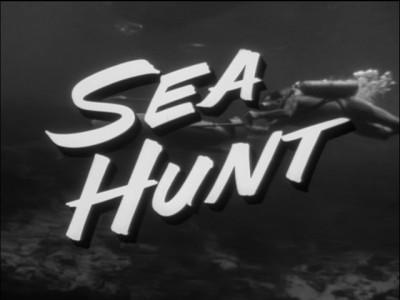
Sea Hunt's set-up couldn't be simpler. Mike Nelson (Lloyd Bridges) is an ex-Navy UDT frogman, now operating as an independent contractor for the last four years. Recognized as one of the leading experts in the comparatively new form of undersea exploration--aqualung skin diving--Mike often works through Los Angeles' Marineland of the Pacific water park, which contracts for him to perform various underwater experiments and data collection, as well as for his unique eye-level observations of marine life. Being his own boss, Mike is free to go wherever he pleases; if a client hires him to find diamonds in a South American river, or rescue a pilot trapped in a submerged jet, or root out illegal aliens scuba-ing their way into the U.S. of A. (America used to be so great...), he just hops into his boat, the Argonaut, and away he goes, with no silly dame to tell him otherwise. And of course, once he accepts an assignment, he eventually discovers how life-threatening each and every one of these jobs are--from empty air tanks, homicidal divers, and giant octopuses and anacondas, to the deathly-seductive "rapture of the deep," Mike Nelson has to be the unluckiest diver in the world.
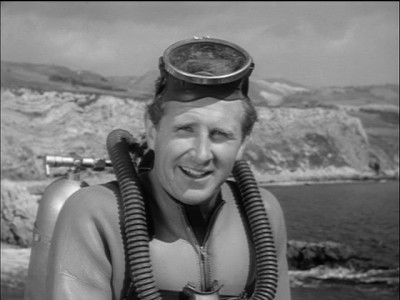
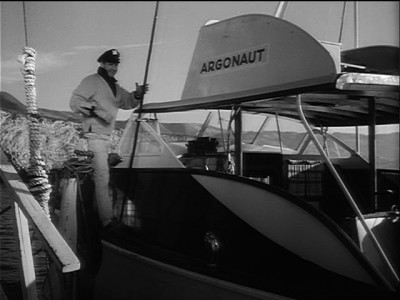
If you've read my vintage TV reviews over the years, then you might get the impression that all I ever did as a kid was watch television--and mostly, you'd be right. But even if I could have stayed awake 24 hours a day, I couldn't have possibly caught every show ever made...particularly since TV wasn't even on 24 hours a day when I was a kid (during the Punic Wars). And contrary to what seems logical, those blind spots in my collective TV memory weren't dictated by a particular show's degree of popularity; just because for decades Sea Hunt was everywhere in syndication, doesn't automatically mean that I had to have watched it...which somehow, I never did. There are still, naggingly, a few "holy grail" titles missing from my viewing history. So I was particularly keen to tackle the first season of this genuinely iconic action/adventure series.
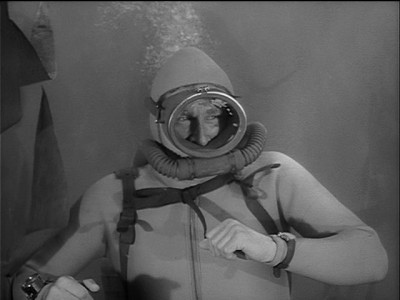
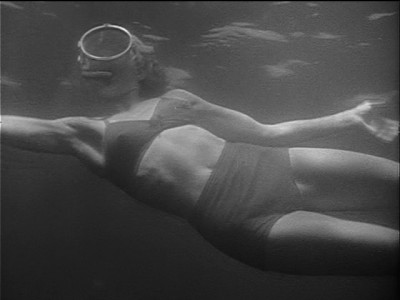
Sea Hunt didn't start out as one of the golden age of first-run syndication's last big successes; it was first shopped around in 1955, in slightly altered form, to the "Big Three" networks by producer Ivan Tors, who had conceived a series about a Navy frogman called Underwater, when he was working on Science Fiction Theater (apparently there are some rumblings out there about when, exactly, Tors came up with Sea Hunt's concept...and its similarities to other proposed projects, but nothing concrete). CBS, NBC, and even lowly ABC all passed on the pitch (the consensus was that the "limited" underwater format couldn't sustain a multi-season series), so Tors hooked up with Ziv Television Productions to bring Underwater to first-run syndication. By 1957 (when the now renamed Sea Hunt's two pilot episodes were shot), first-run syndication wasn't exactly the cash cow it had been just a few years prior. Ziv Television Productions, an independent producing powerhouse led by the legendary radio promoter Frederic W. Ziv, had become so phenomenally successful producing its own TV shows like The Cisco Kid and Highway Patrol to sell either directly to sponsors or television stations (thus bypassing the networks), that the "Big Three" finally figured out that they could do the same thing with their own cancelled series.
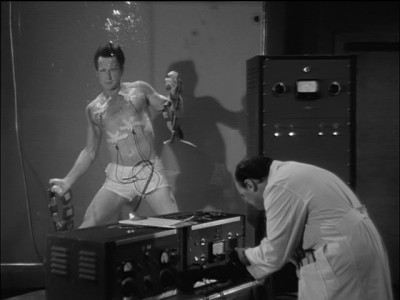
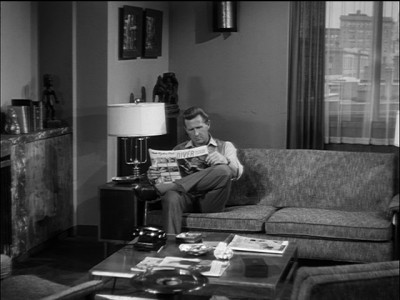
Once that happened, the writing was on the wall for first-run syndication at this point in television's evolution (as a station owner or sponsor, what would you rather do: pay X-amount of dollars for an untried, unproven series, or a deeply-discounted price--since the licensing fee didn't have to recoup already paid-for production costs--for a cancelled network show that had built-in nationwide audience awareness?). Even Ziv was now producing content directly for the networks (if you can't beat 'em, join 'em...). So first-run syndication, far from an ideal first choice, was actually a last resort for Tors and Sea Hunt...as it was for former big screen actor and now Sea Hunt lead, Lloyd Bridges, who didn't exactly want to do a declasse syndication series at this point in his faltering career, but who was "inbetween gigs," as they say, with a big family to feed (never officially blacklisted for being a pinko member of the Commie front, the "Actors' Lab," Bridges was still having difficulty finding steady work). It's only after Sea Hunt's ratings came in, after the January, 1958 premiere, that everyone got happy. Back during these early days of network/station clearances, TV stations' adherence to programming only one network's content was far more fluid than today. If a big city station didn't like what its CBS network partner was offering up for say, a Saturday night time slot, that station owner might plug in his own syndicated offering (or even another network's show). That happened with Sea Hunt in several major markets once the ratings were in from its over 100+ unaffiliated stations. By Tors' and Ziv's estimates, Sea Hunt at its peak was reaching some 40 millions viewers per week, with some rather remarkable audience shares racked up (in a couple of my references, audience shares of over 60% were reported on the nights Sea Hunt aired in major markets). Tors and Ziv (and Bridges) had a huge hit on their hands, resulting in an initial four-year run (ratings were good enough for more seasons, but Bridges wanted out, while the first-run syndication market was almost gone by 1961), followed by literally decades of profitable syndication re-runs, making the show and Bridges iconic Boomer pop culture touchstones.
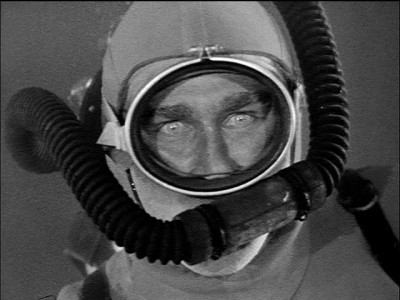
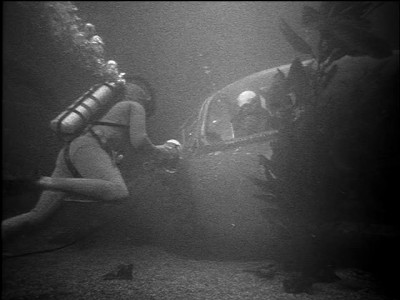
Which leaves us with the show itself. Considering there are 39 episodes to look at here (I just heard a collective groan...), instead of an opening broad overview, let's just dive right in (what? I wasn't going to use that one?). The first broadcasted episode, Sixty Feet Below, was actually the second commissioned pilot for the series...as well as, perhaps, the inspiration for a central plot point in Ian Fleming's James Bond novel, Thunderball. Written by series regular Arthur Weiss, and directed by Felix Feist, Sixty Feet Below sets the Argosy-like men's magazine/adventure "sweats" tone for the rest of the series when Mike, in nicely detached, noir-y narration, details his genuinely exciting race-against-the-clock efforts to rescue a trapped pilot in a submerged experimental jet. The underwater cinematography might be a little murky compared to later efforts shot in Florida, but there's no denying the suspense is genuine, particularly with the inherent, can't-miss fascination of watching Bridges (or rather, his stunt diver) work out a complicated mechanical problem underwater (why the networks didn't think this format would work is anybody's guess). Flooded Mine is even better, from Gene Levitt: Mike has to swim through a flooded mine shaft (!) to see what the damage is, only to discover two men still alive in an air pocket...and he only has additional air for one of them.
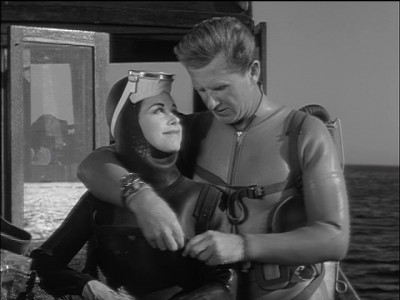
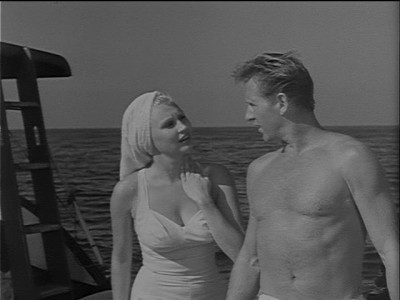
Mike's swinging SoCal lifestyle is hinted at when the episode opens with him swimming alongside his "assistant" babe, Zale Parry (the series' stunt woman...gorgeous in the water), while the multi-climax finale (that buddy breathing on one tank is always surefire) is another nail-biter (I loved seeing tough guy Leo Gordon turn punk underwater). Series regular Leon Benson directly cleanly and efficiently (as indeed do all the Sea Hunt directors). Ellis Marcus' Rapture of the Deep weaves in some light noir elements (divers fighting over a dame) and a moray eel attack in this okay outing, the best part of which is Bridges' explanation of the title condition (the writers always score here when they show us something about diving we don't know). Mark of the Octopus, from Arthur Weiss, was the first pilot shot for the series. Directed by star second unit director Andrew Marton, Mark of the Octopus has everything from porpoises playing basketball ("Come and see us at Marineland, folks!" they bleat), to seriously good-looking Mari Aldon in a skin tight wet suit, to spear gun fights--what more could you want? Mike's fantasy cred as the epitome of the 1950s self-made independent adventurer is solidified here when he's offered a big-paying job with an oil company, and he passes to "stay free."
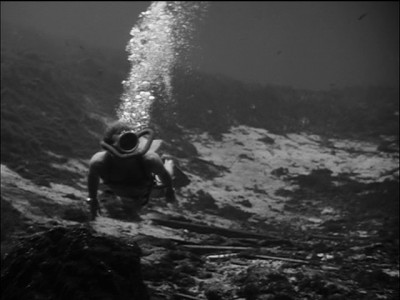
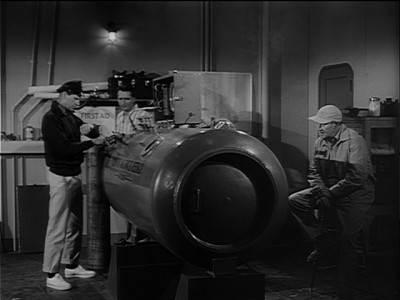
The season's first misfire unfortunately occurs under director Lloyd Bridges' watch with Ellis Marcus' silly, disjointed The Sea Sled, that somehow mixes gangsters and illegal aliens scuba-ing into the U.S. (now they're helpfully flown in at taxpayer expense) with Hungarian freedom fighters of all things. Better are the bad girl antics of Susan Morrow in the appropriately titled Female of the Species, where Mike gets roped into a scam for sunken diamonds. Associate Producer John Florea debuts as series regular director with the fun Mr. Guinea Pig, another noirish outing where Mike's old flame Jan Brooks gets him into one scrape after another (this has one of the season's unintentionally funniest lines--from Stuart Jerome--and line-readings--from Bridges--when we see Mike, in his cool bachelor pad, nonchalantly flipping through a book as we hear him flatly intone, "I was at home reading up on some scientific data when the doorbell rang." Classic). In a good Sea Hunt episode I want some glamour and some danger as I watch Mike muscle his way through the surf, trying to execute some foolhardy plan before his air runs out...so when I see the tiresome peasants of Sonar Queen acting like spooked children at a newfangled fish-finder gizmo, I tune out. Gold Below, from Levitt, is an okay outing where Mike tries to mentor a pupil who gets fooled into diving for incognito treasure hunters (Mike's "The funny thing about trouble...you can always feel it coming," could have come out of any 40s B crime meller).
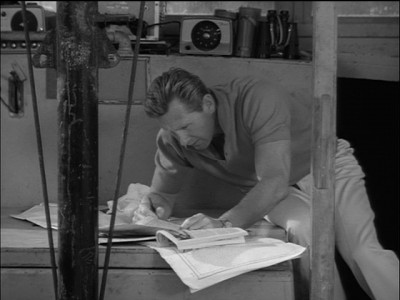
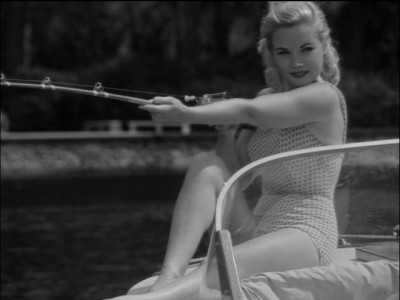
Recovery, from Jack Rock, doesn't make much sense (the Navy won't get its own experimental rocket cone because it's landed in the contested international waters...of the Caribbean?), while Pamela Duncan kept reminding me too much of late-term Judy Garland (whom I cannot picture in a wet suit). Unintentional laughs pepper the delightfully malicious Killer Whale, from Weiss and Andrew Marton, where Mike tells the straight-up truth about Free Willy: "They oughta be destroyed...every last one of 'em!" (I knew those movies were phonies). Take that, PETA! I don't know what's funnier: that phony killer whale fin that keeps flopping over, or Bridges stating that his friend Doug--played by Bridges' underwater stunt double, Courtney Brown--was devoured "in one gulp." Weiss and Marton are back for some much-needed Cold War spy shenanigans in Midget Submarine, where Mike helps an enemy A-bomb scientist defect ("Welcome to the West! " he's told). A real minor Bondian feel to this one, especially when Bridges, clad in his wet suit, is stalking around the boat, spear gun at the ready, and those pre-Thunderball shots, repeated over and over again, of the cool mini-sub in action. The Florida waters here are noticeably clearer than previous Californian shoots.
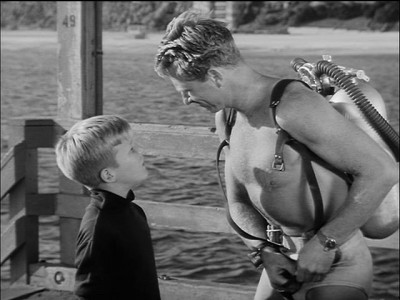
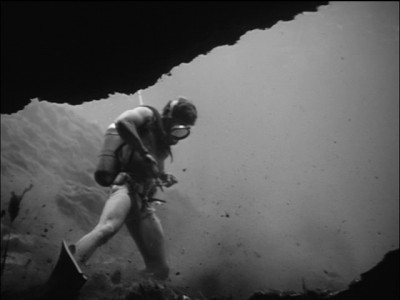
The Shark Cage, a real winner from Lou Huston, mixes tense action with some delicious B noir dynamics as married Tracey Roberts acts like a bitch in heat to anything in pants, deliberately driving her boat captain Tom Brown nuts with jealousy, as she desperately tries to get someone out of Mike's shark repellent study group to nail her. Roberts' wonderfully over-the-top turn competes with Brown's self-sacrifice and the sweet underwater action (you can tell this is syndicated content because the networks' Standards and Practices would never have let her get away with driving her husband to suicide, with no discernible consequences). Hardhat, from Peter R. Brooke, is a solid entry that works because we get involved in Mike's technical problem: how to "break into" an old German sub without destroying the valuable historical contents inside (I also like Mike's barely concealed contempt for the old-timey deep sea diving helmeted/lead booted clowns that clumsily clunk around underwater as he glides by like a dolphin). Portly John Doucette turns up as the most unlikely "good swimmer" you ever saw in The Marvelous Treasure Machine, from Lee Erwin, as Mike suspects trickery with Doucette's "computer treasure finder." Heavy-duty looker Zale Parry shows up again, thank god. Future bigwig scripter Stephen Kandel makes his Sea Hunt debut with the kick-ass The Poacher, where Mike helps Florida game warden John Anderson catch poacher Reed Parham (who apparently was quite an important figure in early skin diving evolution). Good action, nice twists (Bridges getting electrically shocked in the water is cool), and Bridges looks particularly ripped and mean here.
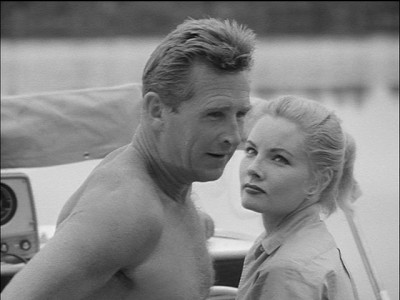
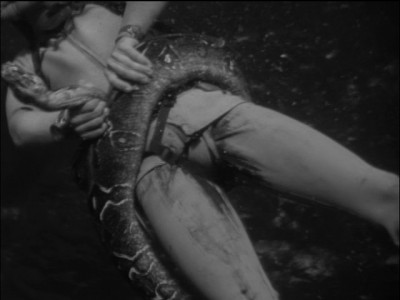
One of the best-looking "unknown" 50s starlets, Jan Harrison, enlivens the pulpy meller, Girl in the Trunk, where Mike becomes involved with magician Guy Rennie and his crappy water trick (seriously...why wouldn't all the padlocks have the same key?). Nice Silver Springs location work--that water is crystal clear--and the ending is hilarious (of course "Baldwin the Great" is going to politely ask Mike to take him to the cops...). Lee Erwin's The Sponge Divers mines a bit of Beneath the 12 Mile Reef for this dopey story of Indeterminate-Ethnicity sponge divers who get their gear squared away by capable Mike Nelson. You may think an underwater land slide is Mike's biggest peril here, but actually it's dinner over at Mike Keene's, complete with shouting, dancing, fisticuffs, and bad accents. A classic bad line here, as Larry Hagman as "Johnny Greco" (hee hee!) pulls a blade on Mike: "Johnny was holding a knife like a man who knew how to use one...that made me feel very vulnerable," while Mike's exit out of Regina Gleason's romantic love life--he sees a picture of her fat mother and literally bolts out the door--should lose about all the female viewers out there. A really bad episode...and really fun.
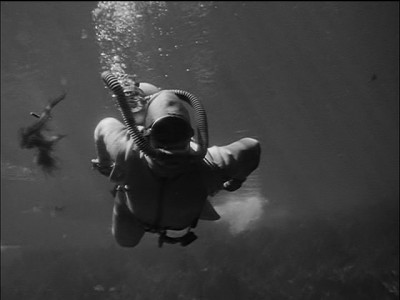
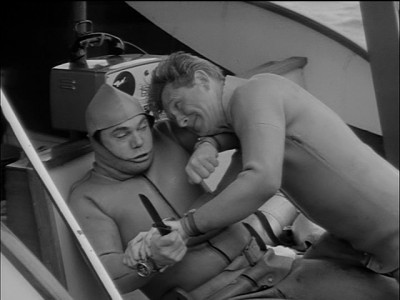
Stephen Kandel returns with the zippy Diamond River, where Mike battles a 30-foot anaconda (no, this isn't a romantic one). Too bad the producers didn't let the snake actually kill the bad guys. Pro scripter Stanley H. Silverman dreams up the wild Alligator Story, where Mike "meets cute" with adorable, sexy Jan Harrison (she's modeling with a rod and reel, and underwater Mike sends a dinner invitation via fish hook), before 'rasslin' a giant alligator in the swamps (only Mike Nelson would embark on such an endeavor in white chinos and a white short-sleeve dress shirt...and not get a smudge on them). Magnetic Mine, from Weiss, is dumb and worse, boring (more wildly gesticulating peasants, a Japanese naval mine that doesn't explode under the people it needs to explode under...like the peasants), while the promising Underwater Patrol, from Jack Rock, spends too much time on dry land, when Mike should be in the water (at least Jan Harrison shows up). Lee Erwin's Legend of the Mermaid is an entertaining--if a bit confusing--entry, with Larry Hagman and Regina Gleason back from The Sponge Divers, but as a different couple...who seem exactly the same. A sweet little mystery--is there a mermaid in that cave?--is solved by Mike, who becomes obsessed like Ahab. You can really tell that's not Bridges when his stunt diver has his mask off for an extended period of time. Classic line from Mike, when he's asked about fear: "Ah...so there is something that you're afraid of," to which he replies, "Naturally--I'm still a bachelor." Peter R. Brooke's Pressure Suit has Mike in a South American lake, looking for a "weed with special properties" (uh huh...), before John Anderson gets the bends real bad. You know, no one ever mentions it when discussing Sea Hunt's popularity, but some of it has to be down to the constant Lloyd Bridges' beefcake on display (and a little bit more, in this particular episode--how his exposed junk got by the censors is completely beyond me). George Asness borrows a lot from The Treasure of the Sierra Madre to come up with The Prospectors, where Mike becomes involved with two paranoid, violent explorers looking for uranium (the main guy is even called "Fred"). The Hero, from Stanley H. Silverman, finds Larry Hagman back again, this time hooked up with gorgeous Jan Harrison as the bored, reckless millionaire Hagman pushes Mike to train him quickly in scuba, so he can bag a shark (Hagman's always great as a sniveling coward).
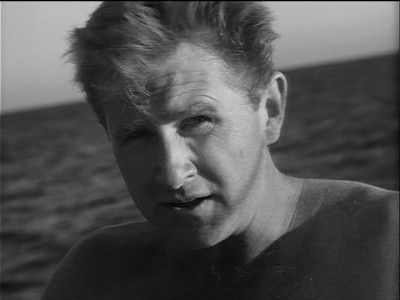
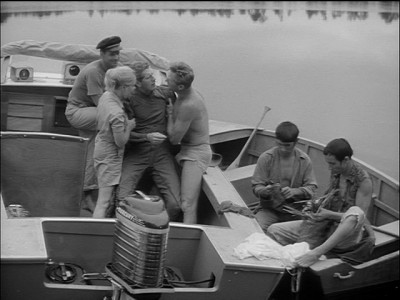
Silverman teams up with Lou Huston for the spiffy little spy outing, Underwater Station, where Mike has to rescue a kidnapped missile scientist, who's being held in an underwater shelter. Cool knife fight in this one. Lloyd Bridges brings in son Jeff for The Lost Ones, from Stephen Kandel, a simple but effective story of Mike saving two kids caught in a cave (their parents are out to lunch). Lots of fun with Sea Hunt's new gadget, the "sea scooter" (I want one of those, man). Capture of the Santa Rosa, from Lee Erwin, is another exceedingly simple set-up--Mike leads an underwater commando raid on a boat--with a nice, clean line of suspense (and again...that sea scooter is sweet). Ellis Marcus doesn't have to do much with a foolproof, proven storyline in The Shipwreck: Mike and a few people are adrift in a small lifeboat for five days. It writes itself. Leonard Nimoy plays a jerk, but Mike generously forgives him (Nimoy's wife is made to beg his forgiveness at the end...even though his behavior was disgustingly weak). And what's with the sudden concern for adhering to the safety rules of real skin diving, when Mike grumbles, "I was foolishly diving alone," at the opening? Of course he was diving alone--that's the show. Ellis Marcus comes up with one of the season's best, The Big Dive, where Mike is leery about helping a fellow diver break a deep dive record. Lots of nice detail on how such a feat would be accomplished (always a Sea Hunt strength). Jeff Bridges comes back for the comic book The Birthday Present, from Robert E. Smith, where Mike's simple gesture of retrieving Jeff's new bike from the ocean deep results in Mike busting gangster "Mr. Waterfront" (this one plays, quite well, like one of those Monogram quickies).
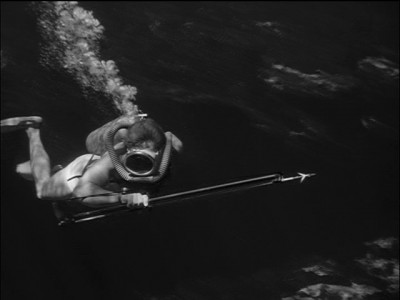
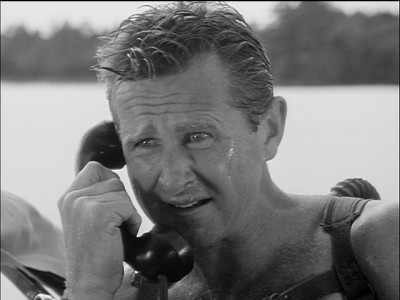
Leonard Nimoy is back in Willaim Reid Woodfellow's Dead Man's Cove, playing another unsavory character: a wife-murderer whom Mike must trick into revealing his crime ("A few gulps of sea water and he become a model prisoner again," is Mike's topper when he roughs up spindly Nimoy). Art Arthur's Killer Rock has a good premise--Mike has to set nitro bombs to blow a navigational hazard--but seriously: what's with all the safety first crap now? It sounds like an instructional video: "No diver should go down without a partner. I sometimes do it when I don't want to involve others in danger, but just the same...it isn't right." So now they're making excuses for the series' irresponsibilities? Booooorrrrrinnnng. Arthur drops the ball, though, with The Amphibian, which doesn't make any sense: how could a spy swim all around a supposedly top-secret underwater rocket launcher...and the Navy is nowhere to be seen? Lord Cristobal, from Arthur Weiss, opens with a surprisingly graphic murder: a diver is repeatedly stabbed to death with a spear, in close-up (you wouldn't see that on the "Big Three"). What follows is a nicely involved suspenser where Mike almost buys it with a carbon monoxide-laced air tank. Art Arthur's Decoy is quite lame: an underwater satellite is fooling the natives into thinking it's a sea monster (the prop satellite is quite amusingly cheap, though). Arthur's blah The Sea Has Ears opens with another unusually violent death: a diver is drowned by his tank valve being shut off. Otherwise...forgettable. Finally, Lee Erwin delivers up the eventful The Manganese Story, where Mike battles everything from a storm to whizzing bullets to (you're going to love this) a giant clam that latches onto his foot like a soup bone (unfortunately, he gets out of it too quickly).
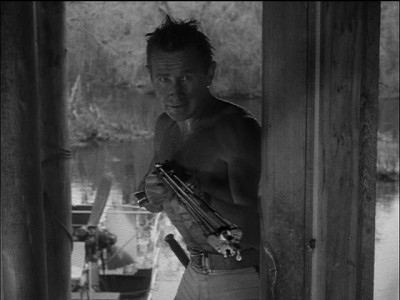

The Video:
The fullscreen, black and white 1.37:1 transfers for Sea Hunt: Complete Season 1 in and of themselves aren't too bad, ranging from earlier episodes looking a bit grainy and contrasty, to later efforts looking sharp and detailed. The problem here is bitrate and interlacing: video noise issues and ghosting at times detracts.
The Audio:
The Dolby Digital English mono audio track is squelchy at times, and a bit shrill, but serviceable. No closed captions or subtitles.
The Extras:
No extras for Sea Hunt: Complete Season 1.
Final Thoughts:
Rapture of the deep, indeed. All Sea Hunt has to do today is entertain, which it does handily with (mostly) involving little suspensers, crisply scripted and directed, with the endlessly fascinating underwater angle making for a nice twist on the standard professional adventurer/crime fighter framework. You couldn't ask for a better lead than Lloyd Bridges: cut, confident, and just disinterested enough not go overboard with the silliness. A classic for a reason. I'm highly, highly recommending Sea Hunt: Complete Season 1.
Paul Mavis is an internationally published movie and television historian, a member of the Online Film Critics Society, and the author of The Espionage Filmography.


|
| Popular Reviews |
| Sponsored Links |
|
|
| Sponsored Links |
|
|
| Release List | Reviews | Shop | Newsletter | Forum | DVD Giveaways | Blu-Ray | Advertise |
|
Copyright 2024 DVDTalk.com All Rights Reserved. Legal Info, Privacy Policy, Terms of Use,
Manage Preferences,
Your Privacy Choices | |||||||














